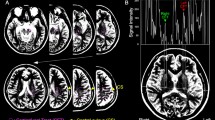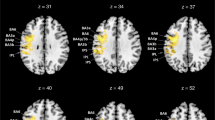Abstract
Hemispheric dominance for motor control in the human brain is still unclear. Here we propose asymmetric sensorimotor integration during human hand movements. We investigated the dexterity of hand movements and related sensory functions in four right-handed patients with cerebrovascular lesions in the postcentral gyrus. To clarify the distributions of cortical damage, semiquantitative analysis of regional cerebral blood flow (rCBF) was performed using single photon emission computed tomography (SPECT), and a three-dimensional surface display was generated from SPECT. Scores on motor and sensory tasks and rCBF values in the patients were compared with those in control subjects. All patients presented with asymmetric clumsiness of complex finger movements, in association with impairments of combined sensations such as stereognosis. These findings were indicative of a disorder of sensory information processing necessary to guide the movements. Two patients with left hemispheric damage showed bilateral clumsy hands, predominating on the right side, while the other two patients with right hemispheric damage showed only a left clumsy hand. In agreement with asymmetric clumsiness, measurement of rCBF along with a three-dimensional surface display revealed cortical hypoperfused areas, mainly in the perirolandic cortices, comprising the primary motor and somatosensory cortices. Perirolandic cortical hypoperfusion was bilateral in the two patients with bilateral clumsy hands, but only on the right side in the other two patients with left clumsy hands. These results suggest a dominant role of the left somatosensory cortex in sensorimotor integration for complex finger movements of humans.
Similar content being viewed by others
References
Deiber MP, Passingham RE, Colebatch JG, Friston KJ, Nixon PD, Frackowiak RSJ (1991) Cortical areas and the selection of movement: a study with positron emission tomography. Exp Brain Res 84:393–402
Gemba H, Sasaki K (1984) Distribution of potentials preceding visually initiated and self-paced hand movements in various cortical areas of the monkey. Brain Res 306:207–214
Haaland KY, Cleeland CS, Carr D (1977) Motor performance after unilateral hemisphere damage in patients with tumor. Arch Neurol 34:556–559
Hikosaka O, Tanaka M, Sakamoto M, Iwamura Y (1985) Deficits in manipulative behaviors induced by local injections of muscimol in the first somatosensory cortex of the conscious monkey. Brain Res 325:375–380
Howes D, Boller F (1975) Simple reaction time: evidence for focal impairment from lesions of the right hemisphere. Brain 98:317–332
Ikeda A, Lüders HO, Burgess RC, Shibasaki H (1992) Movement-related potentials recorded from supplementary motor area and primary motor area. Brain 115:1017–1043
Iwamura Y, Tanaka M, Sakamoto M, Hikosaka O (1993) Rostrocaudal gradients in the neuronal receptive field complexity in the finger region of the alert monkey's postcentral gyrus. Exp Brain Res 92:360–368
Iwamura Y, Iriki A, Tanaka M (1994) Bilateral hand representation in the postcentral somatosensory cortex. Nature 369:554–556
Jeannerod M, Michel F, Prablanc C (1984) The control of hand movements in a case of hemianaesthesia following a pariental lesion. Brain 107:899–920
Jones RD, Donaldson IM, Parkin PJ (1989) Impairment and recovery of ipsilateral sensory-motor function following unilateral cerebral infarction. Brain 112:113–132
Kawabata K, Tachibana H, Sugita M (1991) Cerebral blood flow and dementia in Parkinson's disease. J Geriatr Psychiatry Neurol 4:194–203
Kawashima R, Yamada K, Kinomura S, Yamaguchi T, Matsui H, Yoshioka S, Fukuda H (1993) Regional cerebral blood flow changes of cortical motor areas and prefrontal areas in humans related to ipsilateral and contralateral hand movement. Brain Res 623:33–40
Kim S-G, Ashe J, Hendrich K, Ellerman JM, Merkle H, Ugurbil K, Georgopoulos AP (1993) Functional magnetic resonance imaging of motor cortex: hemispheric asymmetry and handedness. Science 261:615–617
Liepmann H (1920) Apraxie. Erg Ges Med 1:516–543
Mori S, Sadoshima S, Ibayashi S, Iino K, Fujishima M (1994) Relation of cerebral blood flow to motor and cognitive functions in chronic stroke patients. Stroke 25:309–317
Motomura N, Yamadori A, Asaba H, Sakai T, Sawada T (1990) Failure to manipulate objects secondary to active touch disturbance. Cortex 26:473–477
Okuda B, Kawaguchi S, Yamamoto T, Samejima A (1990) Changes in the cerebello-cerebral response in the parietal cortex following ablation of the motor cortex in the cat: early occurrence and persistence. Neurosci Res 8:1–11
Okuda B, Tachibana H, Kawabata K, Takeda M, Sugita M (1992) Slowly progressive limb-kinetic apraxia with a decrease in unilateral cerebral blood flow. Acta Neurol Scand 86:76–81
Okuda B, Tanaka H, Tachibana H, Kawabata K, Sugita M (1994) Cerebral bloow flow in subcortical global aphasia. Perisylvian cortical hypoperfusion as a crucial role. Stroke 25:1495–1499
Oldfield RC (1971) The assessment and analysis of handedness: the Edinburgh Inventory. Neuropsychologia 9:97–113
Remy P, Zilbovicius M, Leroy-Willig A, Syrota A, Samson Y (1994) Movement- and task-related activations of motor cortical areas: a positron emission tomographic study. Ann Neurol 36:19–26
Sasaki K, Gemba H (1984) Compensatory motor function of the somatosensory cortex for the motor cortex temporarily impaired by cooling in the monkey. Exp Brain Res 55:60–68
Seitz RJ, Roland PE, Bohm C, Greitz T, Stone-Elander S (1990) Motor learning in man: a positron emission tomographic study. Neuroreport 1:57–66
Shibasaki H, Sadato N, Lyshkow H, Yonekura Y, Honda M, Nagamine T, Suwazono S, Magata Y, Ikeda A, Miyazaki M, Fukuyama H, Asato R, Konishi J (1993) Both primary motor cortex and supplementary motor area play an important role in complex finger movement. Brain 116:1387–1398
Tachibana H, Kawabata K, Tomino Y, Sugita M, Fukuchi M (1993) Brain perfusion imaging in Parkinson's disease and Alzheimer's disease demonstrated by three-dimensional surface display with 123I-iodoamphetamine. Dementia 4:334–341
Talairach J, Tournoux P (1988) Co-planar stereotaxic atlas of the human brain. Thieme Medical, New York
Weiller C, Ramsay SC, Wise RJS, Friston KJ, Frackowiak RSJ (1993) Individual patterns of functional reorganization in the human cerebral cortex after capsular infarction. Ann Neurol 33:181–189
Yamadori A (1982) Palpatory apraxia. Eur Neurol 21:277–283
Author information
Authors and Affiliations
Rights and permissions
About this article
Cite this article
Okuda, B., Tanaka, H., Tomino, Y. et al. The role of the left somatosensory cortex in human hand movement. Exp Brain Res 106, 493–498 (1995). https://doi.org/10.1007/BF00231073
Received:
Accepted:
Issue Date:
DOI: https://doi.org/10.1007/BF00231073




